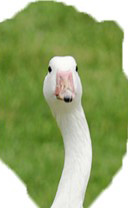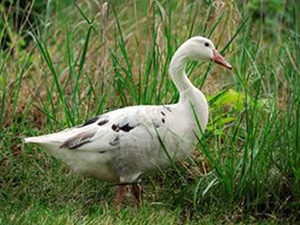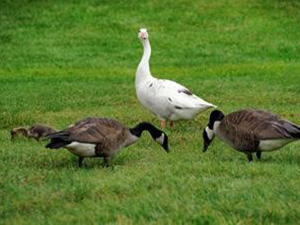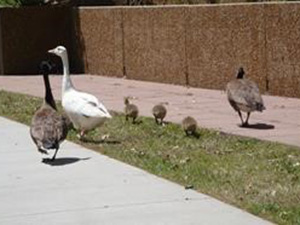L'Oie Toulouse? Qui, Moi?
L'Oie Toulouse? Qui, Moi?
By the Environmental Awareness and Advisory Committee, W.A.I.T, Bill Willis and John McLamb, Investigative Reporters
July 23, 2014
WANTED
Information leading to a positive ID

About three years ago, a white Canada goose (Branta canadensis canadensis) or perhaps an imposter appeared on our NIEHS campus. This bird seemed to come out of nowhere, creating a lot of talk and fascination to this day. Questions have lingered: “where did it come from, why is it here, and what’s its game?” Did it run “a fowl” of the law or is it now part of a federal witness relocation program? Apparently no background check was performed when the bird first appeared. No Federal record seems to exist. We may never know all the answers, but we are trying to get to the bottom of this story. Here’s what we do know.
It’s not unusual for migrating Canada geese (CG) to stop off at NIEHS for a short respite. Our amenities are some of the best around. Over the years, a few birds have become residents, pairing up and raising their young. They have been observed visiting other Institutes in the Park, but never migrating. To see a non-Canada goose is the exception.
Physical Description
Slightly larger than Canada companions; weight ~ 13.0 lbs; height ~33-35 in; length ~ 36-40 in; wing span ~ 66 in; long neck w/ vertical feather patterning; mostly white with some faint grey-brown upper wing patterning; individual black wing feathers; bill, legs, and feet are pinkish orange; eyes are dark with a light cream-colored eye ring; beak has some dark blotches but isn’t thick at base; no grin line; wings lack pronounced dark tipping on the underside; capable of flight; takes to water; and honks.

Feral/domestic geese and wild/resident CG are gregarious and known to share space. This is often observed in community parks and golf courses that have lakes.
Upon arrival, the white goose was pretty much a loner, over time it could be seen feeding and moving with the CG flock around the campus. Could, or would, a domestic goose pair up with a true Canada goose to produce young, and would that pairing be fertile? Last year the white goose accompanied a CG and young. This year there were two Canada geese with goslings of different ages and the white goose observed together. Geese are monogamous and pair for life, so this relationship was indeed interesting. People have observed that CG pairs with young may combine for the protection of the young. Also, experienced goose parents may even take the young of first time parents and protect them as if their own.
Of the three adults seen together this year, the white bird was the most protective, characteristic of a gander with hissing, neck protruding, and raised wings. Could the geese have recruited a nannie to help tend and care for the goslings? Another question “if two pairs joined together wouldn’t there be four CG not just two?”

In the bird world, a female Canada goose chooses the nest location, excavates the earth, collects materials, and builds the nest lining it with her down feathers. During this time a male stands watch and leaves the nest building, and incubation entirely to the female. She even has to lay all the eggs. She can lay as many as 15 eggs but usually averages 5. Clutches this year yielded 4 and 6 goslings. No witness has yet come forward with first-hand information saying that they observed mating, nest building, egg laying, or nest guarding.
It takes about a month for the eggs to hatch, but just 24 hours for the goslings to leave the nest, swim, and forage. The young eat constantly and grow fast. Goslings will stay with the parents for protection and fly by 2-3 months. The family’s bonds will extend well into the following years.

Natural predators include foxes, coyotes, owls, raccoons, and large turtles. Geese are most susceptible to predation as goslings and during the molting period that occurs for 6 weeks during the summer. During this time before new flight feathers grow in, geese can’t fly.
After a lot of honking research, close encounters and discussions with bird watchers and ornithologists at Cornell, NCSU, and elsewhere, we have come to conclude that we can’t come to a conclusion about our bird, without gDNA analysis. One theory is a CG with a partial melanin disorder that causes this phenotype. It would be a true Branta and capable of producing young with the CG. Yet another theory is a hybrid with one CG parent, and one domestic goose (most likely Greylag). A fertile hybrid is also possible.
Hopefully closer observation of the pairs next spring will provide more insights. We expect nesting to again occur on our campus.
If you have additional observations or thoughts to support or refute, please contact John or Bill. We will continue our study and hopefully be able to add more information next year.
We want to thank Tom Simons; NCSU, Philip Bushnell, EPA; Nate Swick, eBird, Cornell; Sherry Coulter, NIEHS; Steve McCaw, NIEHS; Bill Steinmetz, NIEHS for discussion and pictures.
See these sites for a similarly marked goose.



